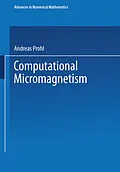Ferromagnetic materials are widely used as recording media.
Their magnetic patterns are described by the well-accepted model of Landau and Lifshitz. Over the last years, different strategies habe been developed to tackle the related non-convex minimization problem: direct minimization, convexification, and relaxation by using Young measures. Nonstationary effects are considered in the extended models of Landau, Lifshitz and Gilbert for (electrically conducting) ferromagnets.
The objective of this monograph is a numerical analysis of these models. Part I discusses convergence behavior of different finite element schemes for solving the stationary problem. Part II deals with numerical analyses of different penalization / projection strategies in nonstationary micromagnetism; it closes with a chapter on nematic liquid crystals to show applicability of these new methods to further applications.
Autorentext
Dr. Andreas Prohl, Universität Kiel
Klappentext
The objective of this monograph is a numerical analysis of the well-accepted models of Landau, Lifshitz and Gilbert for (electrically conducting) ferromagnets. Part I discusses convergence behavior of different finite element schemes for solving the stationary problem. Part II deals with numerical analyses of different penalization / projection strategies in nonstationary micromagnetism; it closes with a chapter on nematic liquid crystals to show applicability of these new methods to further applications.
Inhalt
I: Numerical Stationary Micromagnetism - Direct Minimization - Convexified Micromagnetism - Relaxed Micromagnetism using Young Measures - II: Numerical Nonstationary Micromagnetism - The Landau-Lifshitz-Gilbert Equation - The Maxwell-Landau-Lifshitz-Gilbert Equation - Nematic Liquid Crystals - Summary and Outlook
